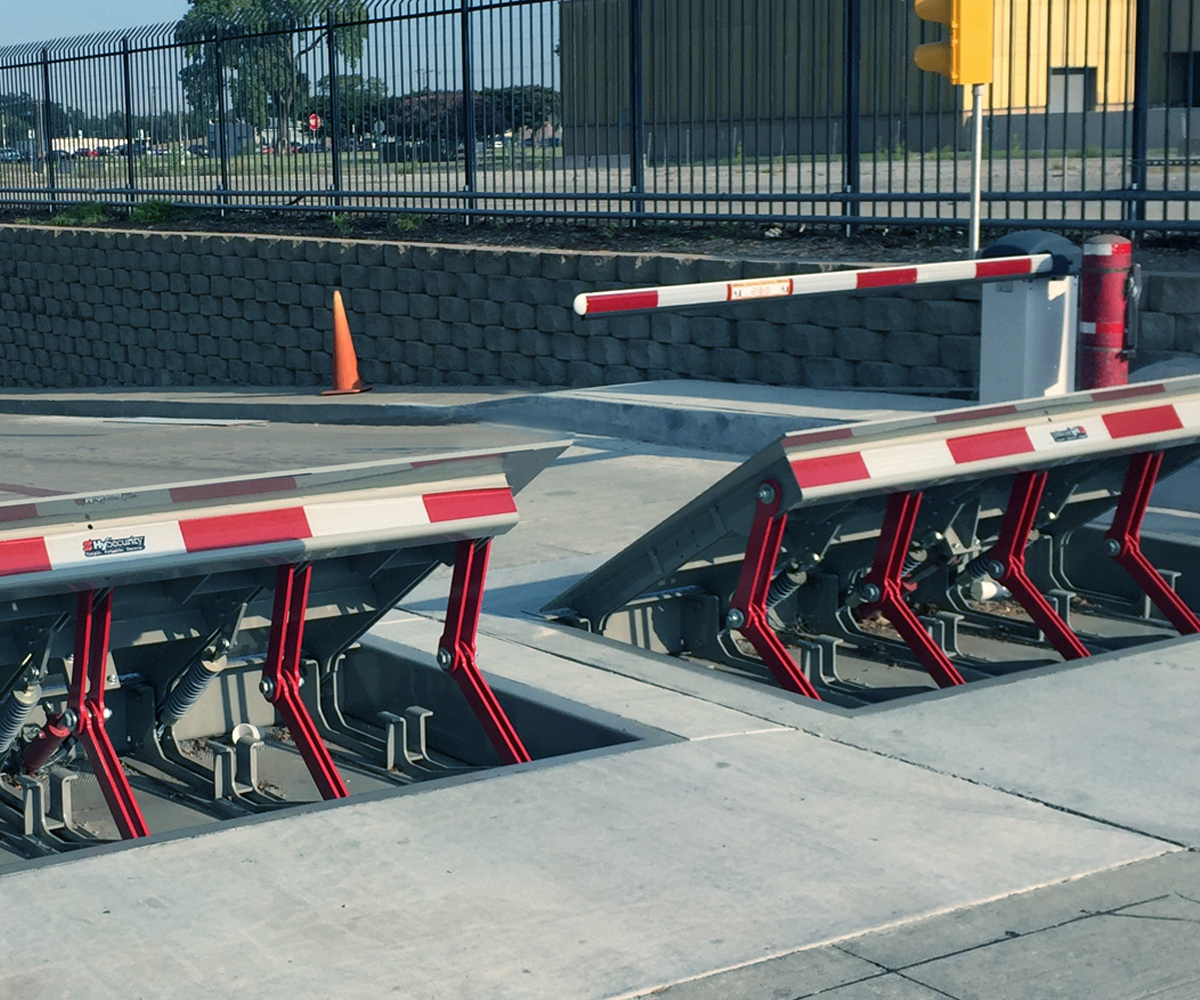Wedge barriers are critical in bolstering security within high-risk zones. These barriers are specifically designed to halt unauthorized vehicle access, making them crucial in protecting sensitive areas such as government buildings, military bases, and industrial facilities. The significance of wedge barriers is accentuated by their ability to withstand high levels of impact, ensuring that they act as an impregnable line of defense against potential intrusions. In high-security environments where the risk of breach is elevated, incorporating wedge barriers is a vital measure to mitigate threats and enhance overall security protocols.
The Importance of Wedge Barriers
Wedge barriers are distinguished by a set of features that position them as indispensable tools in the security arsenal for high-risk zones. Firstly, their low-profile design, when in a non-deployed state, ensures smooth traffic flow while remaining ready for rapid activation. This design is integral to providing both seamless day-to-day operations and instantaneous response in the event of a threat. When deployed, the wedge shape effectively lifts and stops vehicles, even those attempting high-speed breaches, thereby neutralizing the threat efficiently.
Some standout features that underscore the importance of wedge barriers include:
- Rapid Deployment: Modern wedge barriers can rise in mere seconds, effectively blocking unauthorized or threatening vehicles.
- Robust Construction: Often built with reinforced steel or other heavy-duty materials, these barriers can withstand significant force, making them nearly impregnable.
- Integrated Systems: Many wedge barriers come equipped with sensors and electronic controls, allowing for synchronization with broader security systems.
- Space Efficiency: Their design ensures that they do not occupy significant space, thus being perfect for locations with spatial constraints.
- Maintenance Indicators: Advanced models often have diagnostics or indicators to signal when maintenance is due, ensuring they remain in optimal working condition.
Whether it’s an urban environment with heavy vehicular traffic or a remote high-security installation that demands the utmost protection, these barriers can be tailored to fit the requirements. Their modular design, combined with customizable dimensions and specifications, ensures that they are apt for diverse settings, offering robust protection while meeting specific security and operational needs.
What are the Different Types of Wedge Barriers?
Depending on the installation requirements, security needs, and the nature of the terrain, various types of wedge barriers have been developed to cater to different scenarios. Among the most prominent types include:
- Shallow Foundation (or Shallow Mount): As the name suggests, these barriers require a relatively shallow excavation for installation, which makes them ideal for locations where underground utilities or infrastructure may present challenges. Despite their minimalistic foundation depth, these barriers offer formidable stopping power and are often chosen for urban settings or established facilities where in-depth excavation is not feasible.
- Surface Mount: Surface mount wedge barriers are designed for scenarios where excavation is impractical or undesirable. These barriers are mounted directly onto the surface and are anchored firmly to ensure stability and strength. Their design allows for quicker installation compared to their in-ground counterparts, making them suitable for locations that require swift security upgrades.
- Portable: These are the most versatile of the three, designed for temporary or changing security requirements. Portable wedge barriers can be moved from one location to another, offering flexibility in deployment. They are especially useful for events, temporary security checkpoints, or sites undergoing construction where permanent installations might not be necessary.
In choosing the appropriate type of wedge barrier, factors like installation feasibility, expected vehicular threats, and the duration of the security need play pivotal roles. Each type comes with its own set of advantages, ensuring that there’s a solution available for varied security challenges.
Are Wedge Barriers Crash-Rated?
Oe of the primary metrics used to assess the effectiveness of these barriers is their crash rating. This rating indicates the barrier’s capacity to stop vehicles of specific weights traveling at determined speeds. Crash ratings are essential as they provide institutions and security personnel with clear insights into the performance capabilities of a wedge barrier under extreme conditions.
The process of determining crash ratings typically involves rigorous testing under controlled conditions. During these tests, vehicles of different weights and sizes are driven into the barriers at varying speeds to ascertain the barrier’s stopping power and resilience. The results of these tests help in categorizing barriers based on their strength and efficacy. Therefore, when selecting a wedge barrier for installation, it’s crucial to be aware of its crash rating to ensure it meets the specific requirements of the site it is intended to protect.
However, it’s essential to note that not all wedge barriers come with a crash rating. While many models on the market are tested and rated, others might not have undergone the rigorous testing process. As a result, organizations seeking to prioritize maximum security should consider opting for crash-rated barriers. By doing so, they can be assured of the barrier’s tested ability to thwart potential vehicular threats effectively.
Mechanics and Functionality: How Wedge Barriers Operate
Wedge barriers operate as formidable security structures, primarily designed to halt unauthorized vehicle access in high-security zones. These barriers are embedded in the road and remain flush with the road surface when not in use, allowing for normal vehicle and pedestrian traffic. When activated, they swiftly rise from the ground, forming an impenetrable blockade, capable of stopping even high-speed vehicles. The swift and sudden elevation of the barriers acts as a deterrent, effectively preventing unauthorized vehicles from proceeding, and can be integral to the security of facilities like military bases, government buildings, and other sensitive areas.
The mechanics behind wedge barriers are relatively intricate, combining hydraulic, electrical, and mechanical components to ensure swift and reliable operation. Typically, a hydraulic pump, powered by an electric motor, drives the mechanism that raises and lowers the barrier. This system needs to be exceptionally responsive, allowing the barriers to elevate in a matter of seconds when a threat is detected. Sensors and advanced control systems are often integrated into the barriers to detect incoming vehicles and control the operation of the barrier, ensuring that the response is timely and the risk of failure is minimized.
The functionality of wedge barriers extends beyond mere physical obstruction. They are usually part of a comprehensive security system, integrating with other security measures like surveillance cameras, motion detectors, and alarm systems to provide a multi-layered security approach. This integration allows for real-time monitoring and control, enabling security personnel to assess threats quickly and respond appropriately.
Potential Challenges in Deploying Wedge Barriers
Installing wedge barriers can be disruptive, requiring excavation and potentially impacting regular traffic flow and operations of the facility. Furthermore, the integration of these barriers with existing security systems can pose compatibility issues, especially if the current systems are outdated or utilize different technological standards. There’s also the challenge of training security personnel and staff on the use and maintenance of these barriers, ensuring they can operate them efficiently and respond to malfunctions or emergencies.
Addressing these challenges necessitates a proactive and well-thought-out approach. Here are potential solutions to mitigate the complications
- Phased Installation: Implement the installation in stages, ensuring minimal disruption to regular operations.
- Thorough Site Assessment: Before deployment, conduct a detailed evaluation to determine the best locations and methods for installation.
- Regular Training: Conduct periodic training sessions for security personnel, ensuring they’re up-to-date with the operation and maintenance of the barriers.
- System Upgrades: Before integrating wedge barriers, consider updating the entire security system to ensure compatibility and enhanced efficiency.
- Dedicated Support: Collaborate with vendors who provide round-the-clock support and maintenance, ensuring swift resolution of any issues.
While wedge barriers are designed for durability, like any machinery, they can be susceptible to wear and tear, especially in regions with extreme weather conditions. It’s crucial to implement a regular maintenance schedule, ensuring the barriers remain in optimal working condition.
Maintenance and Longevity of Wedge Systems
Maintaining the efficiency and reliability of wedge systems is paramount in ensuring the long-lasting protection they provide to high-security zones. Regular upkeep helps in identifying potential issues early, averting unforeseen failures and disruptions that could compromise the security of the area they protect. The maintenance routines often include inspecting the hydraulic systems, checking for signs of wear and tear, and verifying the system’s responsiveness to ensure optimal functionality.
Regular inspections are paramount to ascertain that the mechanical components and electronics of the wedge barriers are functioning correctly. Over time, debris can accumulate, hydraulic systems might need fluid replenishment, and wear and tear can affect moving parts. Scheduled checks and timely interventions can preempt larger mechanical failures and reduce potential downtime. Furthermore, periodic software updates, if applicable, can enhance system responsiveness and adapt to evolving security demands.
The longevity of wedge systems is also influenced by the quality of their initial installation and the materials used in their construction. Investing in high-quality systems with corrosion-resistant components can substantially extend the service life of wedge barriers. Pairing this with a proactive maintenance regimen ensures that the system operates at peak performance for years, safeguarding facilities while minimizing the need for frequent replacements or major repairs.
Contact R3 Access
With a diverse portfolio of state-of-the-art wedge barriers, gate operators, and advanced access control systems, our team is committed to ensuring your property’s safety and security. Whether you’re considering the implementation of wedge barriers, seeking advice on access control systems, or simply have questions about our range of services, don’t hesitate to contact us today. At R3 Access, your security is our utmost priority, and we’re here to assist you every step of the way.


